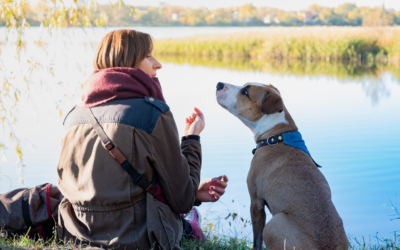Dogs are incredibly loyal and loving companions, but like humans, they can experience anxiety. It's important for dog owners to recognize the signs of stress and understand its causes to help their furry friends live happy and stress-free lives. In this article, we will delve into the world of canine anxiety, exploring its various types, its impact on a dog's health, and techniques to reduce and manage anxiety.
Understanding the Signs of Anxiety in Dogs
Our furry friends may not be able to communicate their feelings through words, but they certainly have their own way of expressing anxiety. Recognizing these signs is crucial in identifying and addressing the issue at hand. When a dog is experiencing anxiety, they may exhibit a range of physical and behavioral changes.
Anxiety in dogs can be triggered by various factors such as loud noises, changes in routine, or even past traumatic experiences. It's important for pet owners to create a safe and comforting environment for their dogs to help alleviate anxiety triggers.
Behavioral Changes Indicating Anxiety
In addition to physical symptoms, dogs may display behavioral changes when feeling anxious. These changes can include excessive barking or howling, destructiveness, pacing, or hiding. Anxiety can also lead to aggression in some dogs.
Watching your dogs' body language can help you begin to determine if your dog is experiencing anxiety. Some examples of things you might notice in your dog when they're anxious include: lowered posture and head, ears that are back or lowered, lowered or tucked tail, and wide eyes. Dogs may also yawn, lick their lips, and turn their head away from something that is worrying them.
Understanding the root cause of a dog's anxiety is crucial in developing a tailored approach to address their specific needs. Behavioral training, desensitization exercises, and a consistent routine can all play a significant role in helping a dog cope with anxiety positively.
Physical Symptoms of Anxiety
Anxiety in dogs can manifest itself through various physical symptoms. Pay close attention to changes in their body language, such as restlessness, excessive panting, trembling, or even an increased heart rate. Some dogs may also experience digestive problems, like diarrhea or vomiting, which can further exacerbate their anxiety.
Pet owners must monitor their dog's physical symptoms and consult a veterinarian if they notice any concerning changes.
The Causes of Anxiety in Dogs
Now that we have a better understanding of the signs of anxiety in dogs, it's essential to explore the underlying causes. Anxiety in dogs can stem from a variety of factors, including environmental triggers and genetic predispositions. Previous experiences and socialization can also have an impact.

Anxiety in dogs is a complex issue that a combination of environmental factors and genetic predispositions can influence. Understanding these causes is crucial in providing the best care for our canine companions.
Environmental Factors
Just like humans, dogs can be sensitive to their environment. Changes in routine, loud noises, new people or animals in the household, or even traumatic experiences can all contribute to feelings of anxiety in our furry friends. It's important to create a calm and secure environment for our dogs to help alleviate their anxiety.
Additionally, environmental enrichment can play a significant role in reducing anxiety in dogs. Providing mental stimulation through interactive toys, regular exercise, and a comfortable living space can help keep their minds engaged and reduce stress.
Genetic Predispositions
While environmental factors play a significant role, genetics can also contribute to a dog's predisposition to anxiety. If a dog has a family history of anxiety-related issues, they may be more likely to experience it themselves. Understanding the genetic factors at play can help in managing their anxiety effectively.
If you're struggling with your dog and anxiety, you may want to work closely with your veterinarian and an animal behaviorist or behavior consultant to develop a holistic approach to managing anxiety in dogs. By addressing both the environmental triggers and genetic predispositions, we can help our furry friends lead happier and more relaxed lives.
Different Types of Anxiety in Dogs
Anxiety in dogs is not a one-size-fits-all phenomenon. Just like humans, dogs can experience different types of anxiety. Two common types are separation anxiety and fear-related anxiety.

Aside from separation anxiety and fear-related anxiety, dogs can also experience situational anxiety. Situational anxiety can be triggered by specific events or circumstances such as car rides, visits to the vet, or loud noises. Dogs may exhibit symptoms like panting, pacing, or trying to escape when faced with these situations. It's important for dog owners to recognize these triggers and provide support to help their furry friends cope with their anxiety.
Separation Anxiety
Separation anxiety is a type of anxiety that occurs when a dog is separated from their owner or left alone for an extended period of time. Dogs with separation anxiety may exhibit destructive behaviors, vocalize excessively, or show signs of distress when their owner is not present. This type of anxiety can be challenging for both the dog and their owner, but with patience and training, it can be managed effectively.
Fear-Related Anxiety
Fear-related anxiety in dogs stems from specific triggers or situations that cause fear and distress. Common triggers can include loud noises (thunderstorms, fireworks), encountering unfamiliar people or animals, or being in unfamiliar environments. Dogs with fear-related anxiety may display avoidance behaviors, aggression, or even panic when facing their fears. Understanding and addressing these fears is essential in helping our dogs feel safe and secure in the world around them.
The Impact of Anxiety on a Dog's Health
Anxiety doesn't just affect a dog's emotions; it can also have a significant impact on their overall health and well-being. Let's explore the physical and mental health consequences that anxiety can have on our beloved furry companions.

Understanding the physical and mental toll anxiety can take on dogs is crucial for providing them with the care and support they need. By delving deeper into these consequences, we can better equip ourselves to recognize and address anxiety in our canine friends.
Physical Health Consequences
When a dog experiences chronic anxiety, it can take a toll on their physical health. Elevated stress hormones can weaken their immune system, making them more susceptible to illnesses and infections. Anxiety can also lead to gastrointestinal problems, which further compromises their overall health.
In addition to weakened immunity and gastrointestinal issues, chronic anxiety in dogs can manifest in various physical symptoms. These may include excessive shedding, skin irritations, and even weight loss due to decreased appetite. Monitoring our dogs for these physical signs can help us intervene early and prevent further health complications.
Mental Health Consequences
Just like humans, dogs have mental health that needs to be nurtured and protected. Anxiety can cause chronic stress, which can lead to depression, decreased appetite, and a general decline in their overall mental well-being. It's essential to recognize and address anxiety in order to ensure our dogs enjoy a fulfilling and happy life.
Furthermore, untreated anxiety in dogs can not only impact their mental health but also hinder their ability to learn and retain training. Dogs experiencing high levels of anxiety may struggle to focus, follow commands, or engage in social interactions with other pets and humans. By prioritizing their mental well-being, we can help our dogs lead balanced and enriched lives.
Techniques to Reduce Anxiety in Dogs
Now that we understand the signs, causes, and impact of anxiety in dogs, let's explore various techniques that can be effective in reducing anxiety and providing our furry friends with the support they need.
Training and Behavior Modification Techniques
Positive reinforcement-based training can be invaluable in reducing anxiety in dogs. Teaching them basic cues, such as “sit” and “stay,” can help create a sense of structure and security. Gradual desensitization to triggers that cause anxiety can also be effective in helping dogs overcome their fears. Seeking the guidance of a behaviorist or behavior consultant can provide personalized strategies for managing anxiety.
For example, a dog who becomes anxious during thunderstorms can be gradually exposed to the sound of thunder at a very low volume while receiving treats. Over time, the volume can be increased, helping the dog associate the sound with positive experiences. This technique, known as desensitization and counterconditioning, can help dogs develop a more positive response to anxiety-inducing stimuli.
The Role of Exercise and Play
Regular exercise and engaging playtime are essential for a dog's overall physical and mental well-being. Physical activity releases endorphins, which can help reduce anxiety and stress in dogs. Interactive toys and puzzle games can also provide mental stimulation.
Consider taking your furry friend for a long walk or engaging in a game of fetch to help them release pent-up energy and reduce anxiety. You can also explore new environments, such as hiking trails or dog parks, to provide mental stimulation and socialization opportunities. These activities promote physical health and help build confidence and reduce anxiety in dogs. If there are triggers for your dog on these walks, then ensure that you avoid them to try to make the walk positive for both you and your dog.
Additionally, incorporating calming activities into your dog's routine can be beneficial. Some dogs find comfort in activities such as nose work, where they use their sense of smell to search for hidden treats or toys. This mental stimulation can help redirect their focus from anxiety-inducing thoughts to a fun and rewarding task.
We can significantly reduce anxiety in our beloved furry friends by employing a combination of training and behavior modification techniques, providing a secure environment, and ensuring regular exercise and play. Remember, each dog is unique, and what works for one may not work for another. Patience, understanding, and much love are the keys to helping our anxious dogs lead happier and healthier lives.



